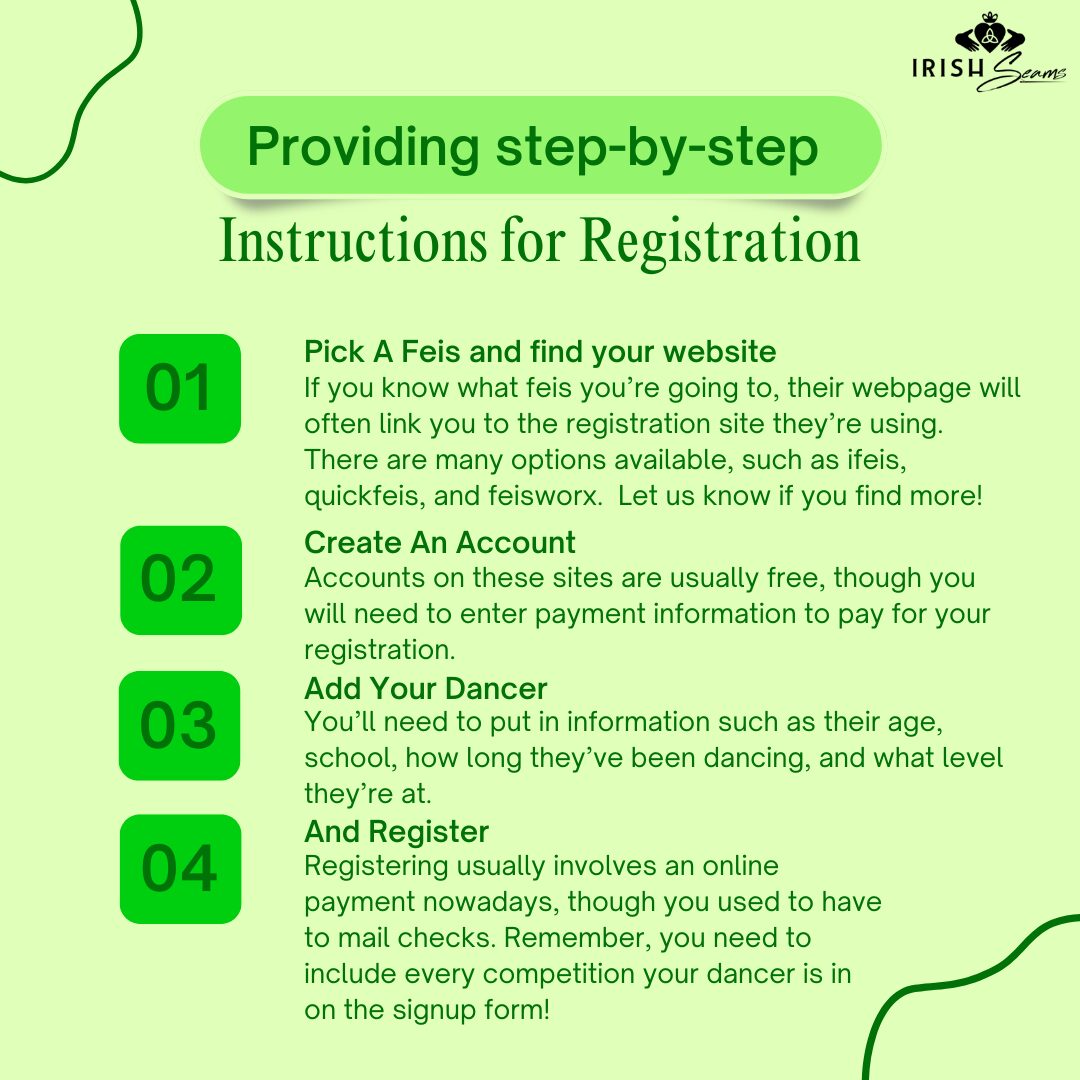
So, you’ve joined an Irish dance school and your teacher has been talking about going to your first feis soon. That’s great news! But how do you sign up for a feis again? How do you even find them to begin with? The process can be a little complicated, so we’ve made this overview to help take the confusion out of things. For your first feis your teacher will often help you with a lot of these decisions- which feis to go to, which site to register with, which dances to sign up for, and so on- but this guide will hopefully answer a few of your questions before you need to ask them!
Sometimes feiseanna will have you register through their own website or the website of a school organizing the event, but most feiseanna use online registration sites. To use these, you will usually need to make a free account on the registration site and add the information of each dancer in your family. Once you’ve done that you can look up the feis you want to go to (most of these sites have a list of all the upcoming feis they serve sorted by date), register your dancers, and pay the fee. There are a good number of these sites around, so we’ll include a list below:
If you use other feis registration websites, let us know on our facebook page so we can expand this list and get them more traffic.
Additionally, there are a handful of feis calendar sites that collect information about a large number of feis and direct visitors to the correct registration sites. These can be very useful when you want to see if there are any feiseanna on a specific weekend or see all the upcoming feiseanna in a region to check which ones are near you. This includes sites like:
https://www.facebook.com/groups/470691973444868/ for the mid-atlantic feis facebook page.
These can all be useful ways of tracking down which feis you want to register with and which site to register on. Once you’ve made your way to the correct registration site and created your account, you’ll need to register for your feis and enter your dancer’s information so they’re in the right competition set. This will include things like your dancer’s age range and your dancer’s competition level for each dance.
Age ranges for Irish dance are relatively intuitive: the letter ‘U’ followed by a number means dancers younger than that age, the letter ‘O’ followed by a number means dancers above that age and is usually the oldest age group in that competition. This is determined by the year the competitor is born- if a dancer is 12 years old on January 1st, they will dance in U13 the entire year.
Where it gets a little complicated is the ‘Adult dancer’ category. Adult dancers aren’t listed like that just because they’re older than 18, they have to meet one of these requirements:
1: They started dancing after the age of 18.
2: Are older than 18, haven’t competed in 5 years, and have never placed in the top 3 of a youth preliminary championship dance with at least 5 dancers.
The requirements are a little odd in how specific they are, but it rarely comes up in practice. Dancers that qualify as adults can only register for adult categories.
From there, we have competition levels. This article is mostly written for people who are just starting out, so we’re only going to cover some general knowledge and the first few competition ‘grades’ here. There are many more after this, and you should check out IDTANA’s glossary here if you’re interested in learning more. As these are IDTANA’s requirements in our example, there may very well be differences in different regions, groups, and schools.
First Feis: dancers at their first feis fall into this category. It isn’t available at every feis, but it’s typically well-received when it is.
Beginner: a dancer who has not taken a full year of lessons, usually decided by whether they were taking classes before September 1st of last year. Dancers typically only compete in soft shoes/ghillies at this level and below.
Advanced Beginner: a dancer who has taken a full year of lessons, but not won 1st, 2nd, or 3rd place. This is the level where the full range of dances becomes available to dancers. Once a dancer has placed 1st, 2nd, or 3rd in a dance at this level, they can advance to the next level, Novice, in that dance.
There are a few things that are important to remember. The first is that usually there have to be at least five dancers in a competition for it to ‘count’ as a win for the purposes of moving up, and feiseanna will occasionally combine age brackets if they’re not filled out enough. The second is that a dancer’s competition grade can be different for each dance- you could be a Novice in your Slip Jig and only an Advanced Beginner in your Reel. Third is that these are IDTANA’s minimum standards for advancement, and individual schools often have more requirements like demonstrating that you’ve learned certain dances well enough or placing multiple times before advancing. Usually this comes up more at higher levels, but it’s a good thing to keep in mind when planning how many feis you want to go to. So now that you’ve registered, what next? Your first feis or three can be a hectic experience, but we’ve got just the thing to help you through it. Check out our article on surviving your first feis here. And if you’ve got any comments or questions, shoot us a message on facebook!

